|
||||
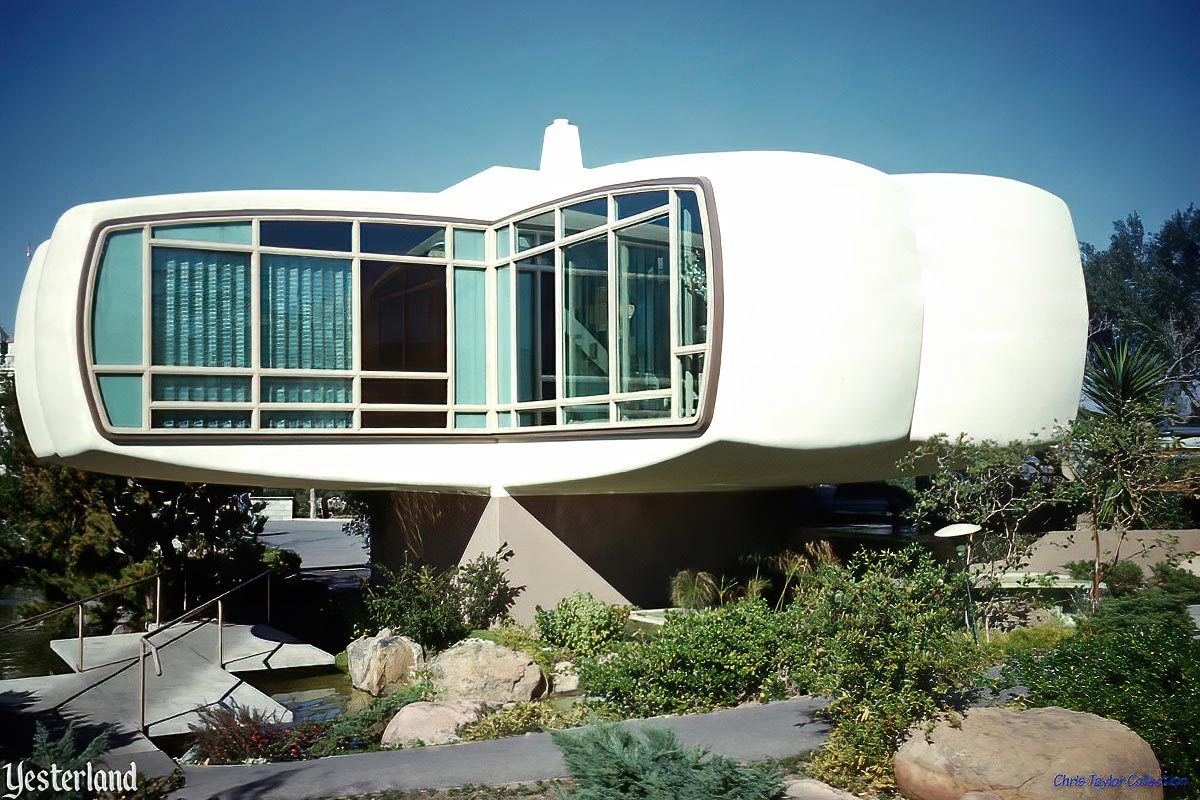
Photo by Charles R. Lympany, courtesy of Chris Taylor |
||||
|
You’re visiting Yester-Tomorrowland between 1957 and 1967. Get ready to say goodbye to plaster walls, wooden furniture, wool carpets, and other traditional home items—and hello to their ultra-modern, synthetic replacements. |
||||
|
|
||||
|
The House of the Future is a preview of what your next house might be like. This demonstration of style and technology will have you dreaming of entire neighborhoods of such futuristic houses. |
||||
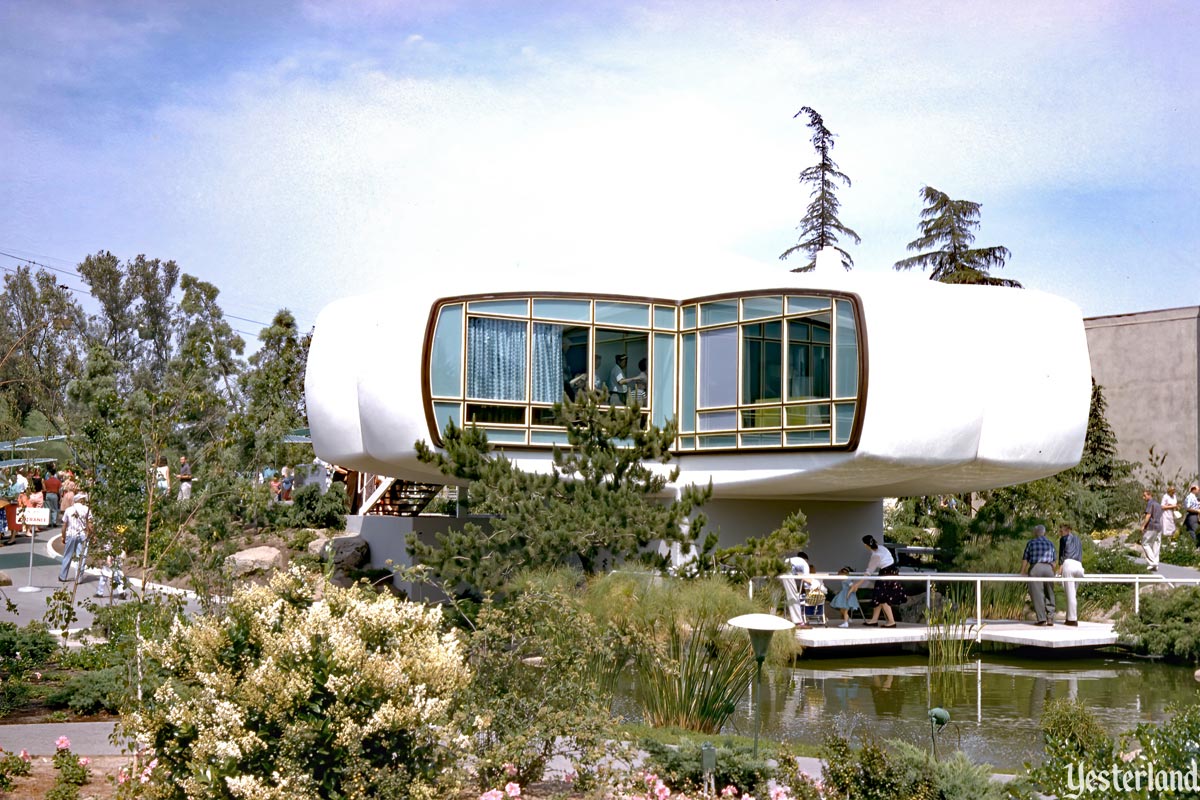
Photo by Merrill A. Garner, 1958, courtesy of M. Scott Garner Geometrically perfect house with artistically perfect landscaping |
||||
|
Before you go inside, admire the outside. The House of the Future looks like nothing in your neighborhood. It has four equal cantilevered wings, each projecting 16 feet from a concrete center core. The wings are “floating” above beautifully landscaped grounds and waterfalls. |
||||
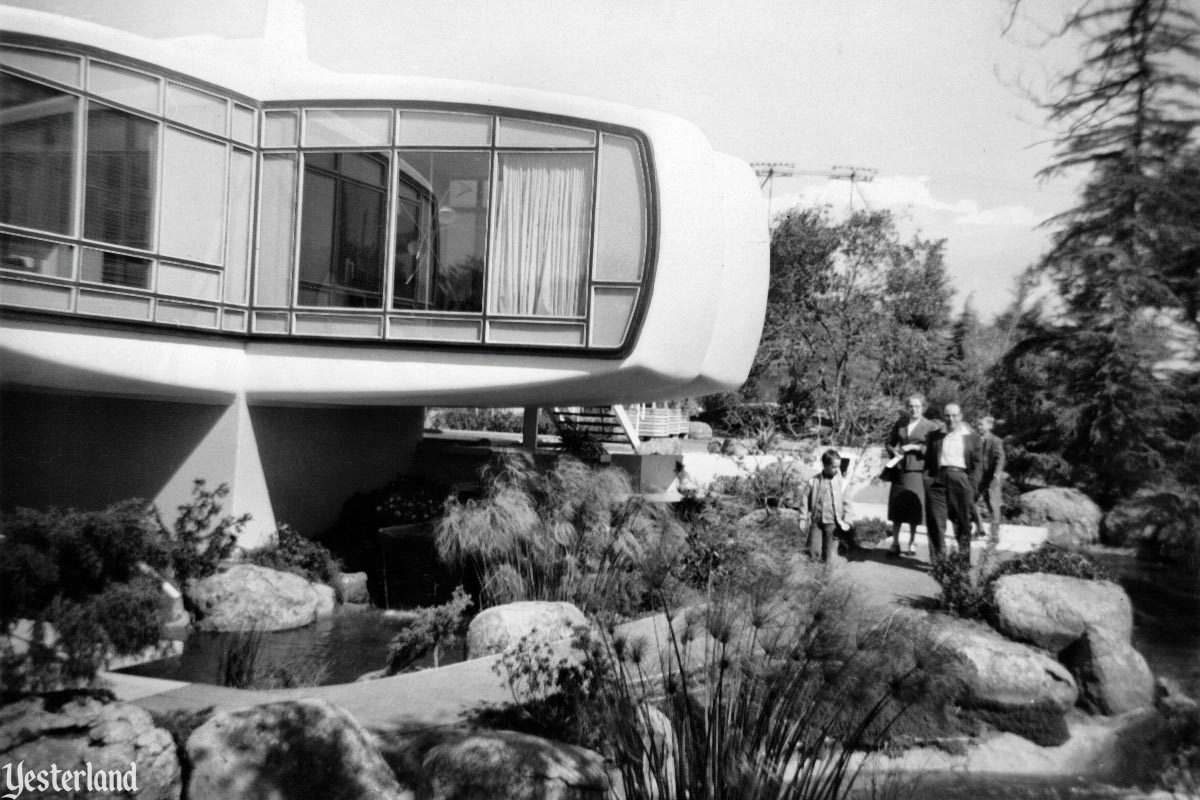
Photo courtesy Orange County Archives, from the Linda Peach Warner Collection On the rocks |
||||
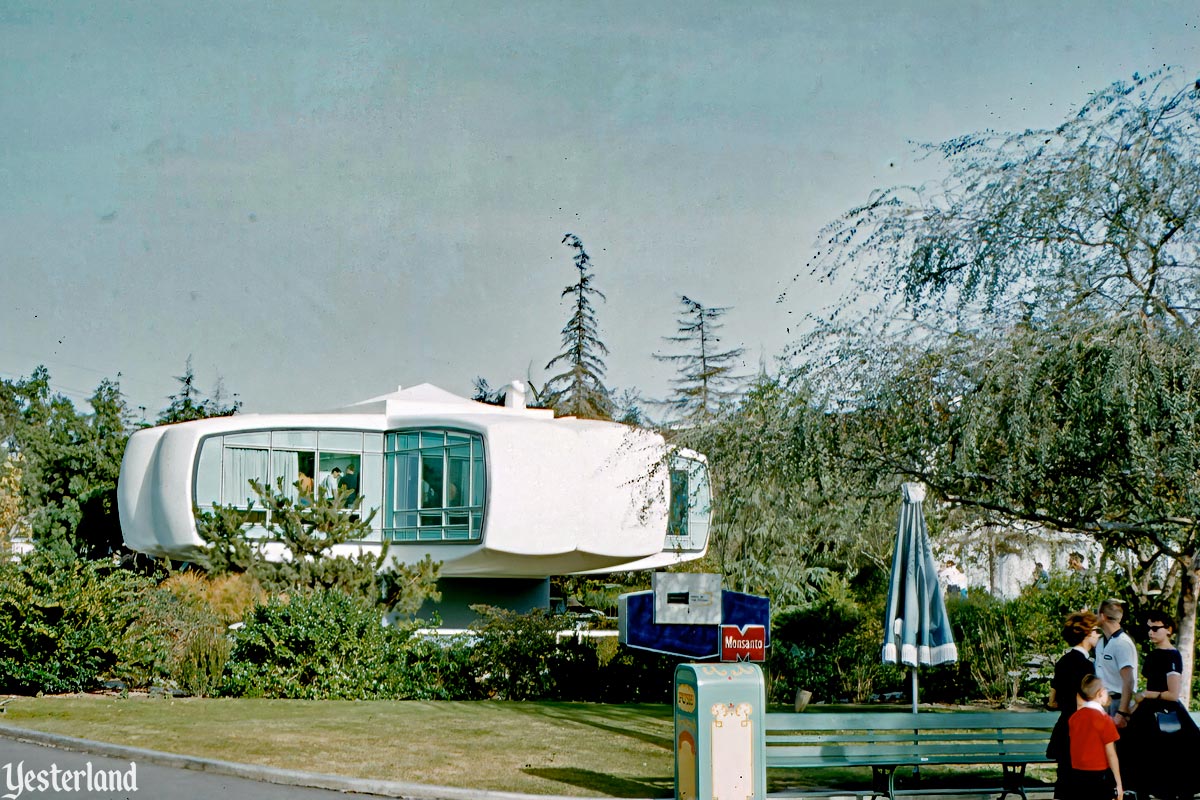
Photo by Roger J. Runck, 1959, courtesy of Robin Runck Red “M” Monsanto logo on the attraction sign |
||||
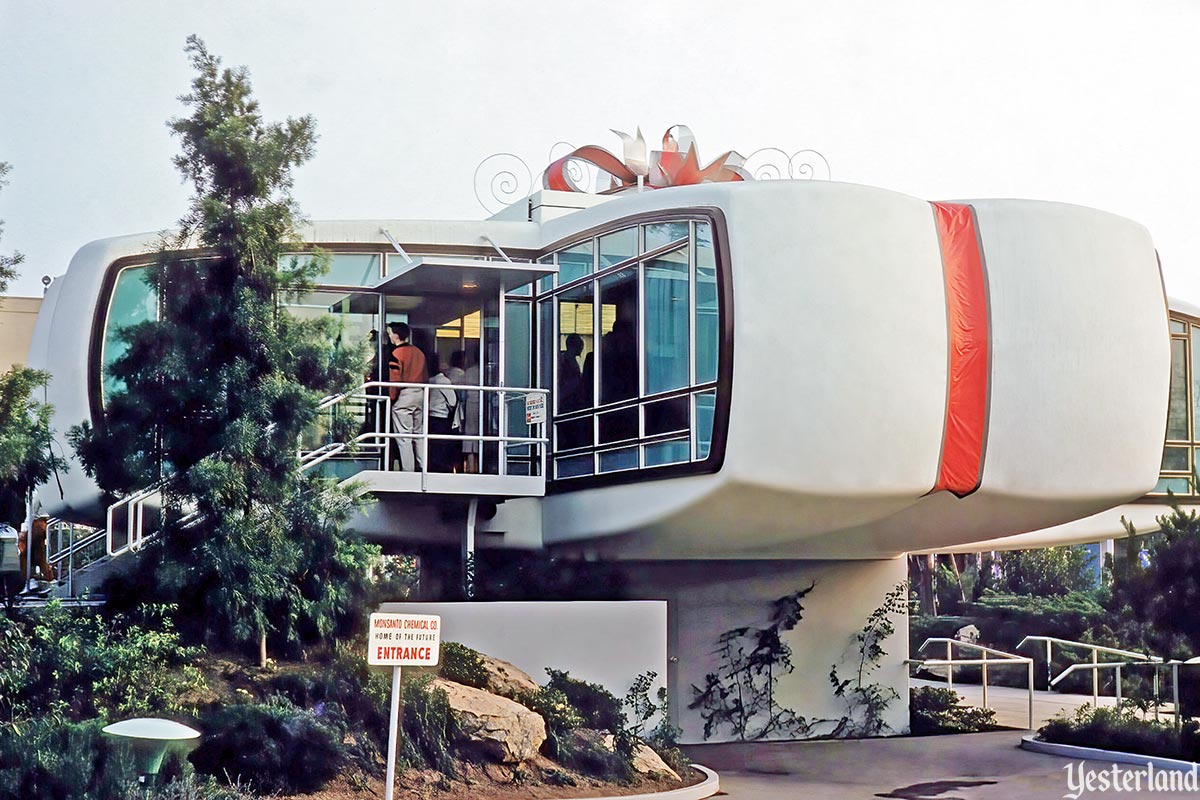
Photo by Charles R. Lympany, courtesy of Chris Taylor Ribbon and bow as Christmas decorations |
||||
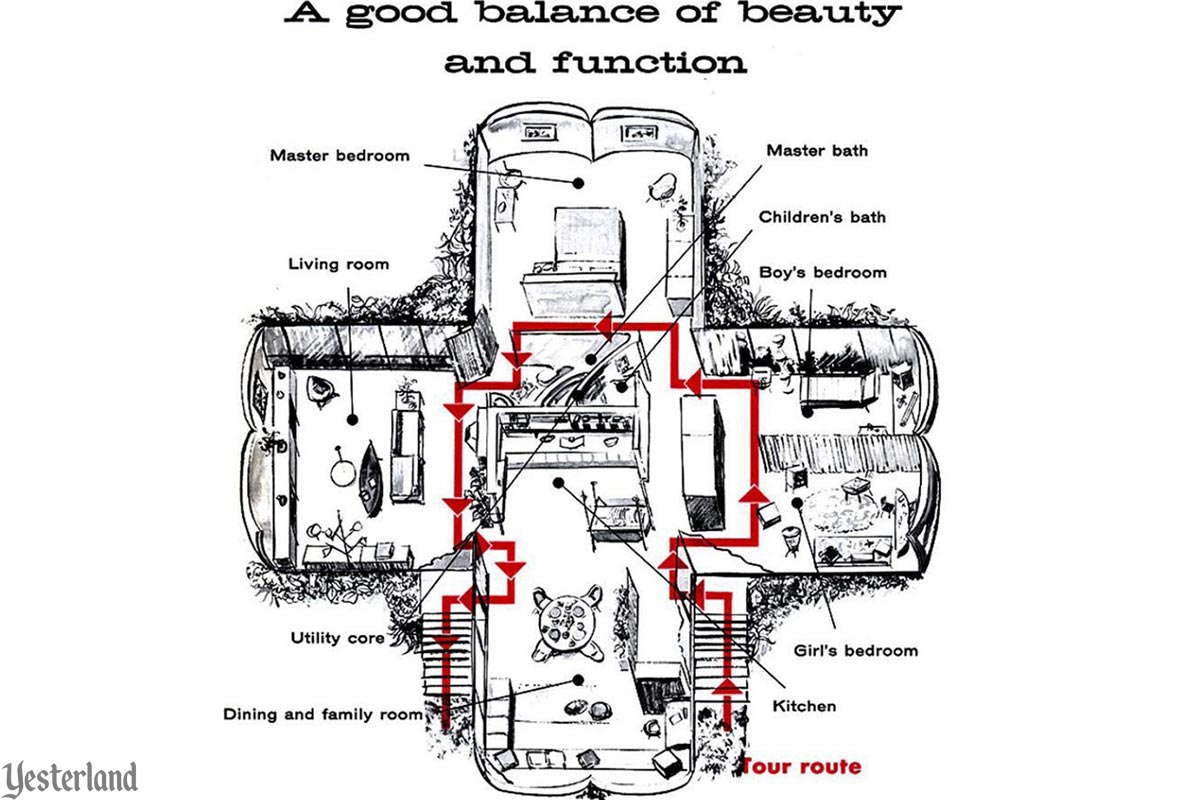
diagram © Disney Floor plan of your tour |
There’s no need to reach for your ticket book. This is a free attraction, courtesy of the Monsanto Chemical Company of St. Louis, Missouri. Start your visit with a walk up a short flight of stairs. Glance into the dining and family room, a comfortable place where the family of the future will play, rest, and dine on stylish plastic furniture. Your eyes will be drawn to the “Atoms for Living Kitchen” with its revolutionary microwave oven and ultrasonic dishwasher. The kitchen and bathrooms are all located in the center core. It’s an efficient layout—and every faucet and shower head is near the water heater. |
|||
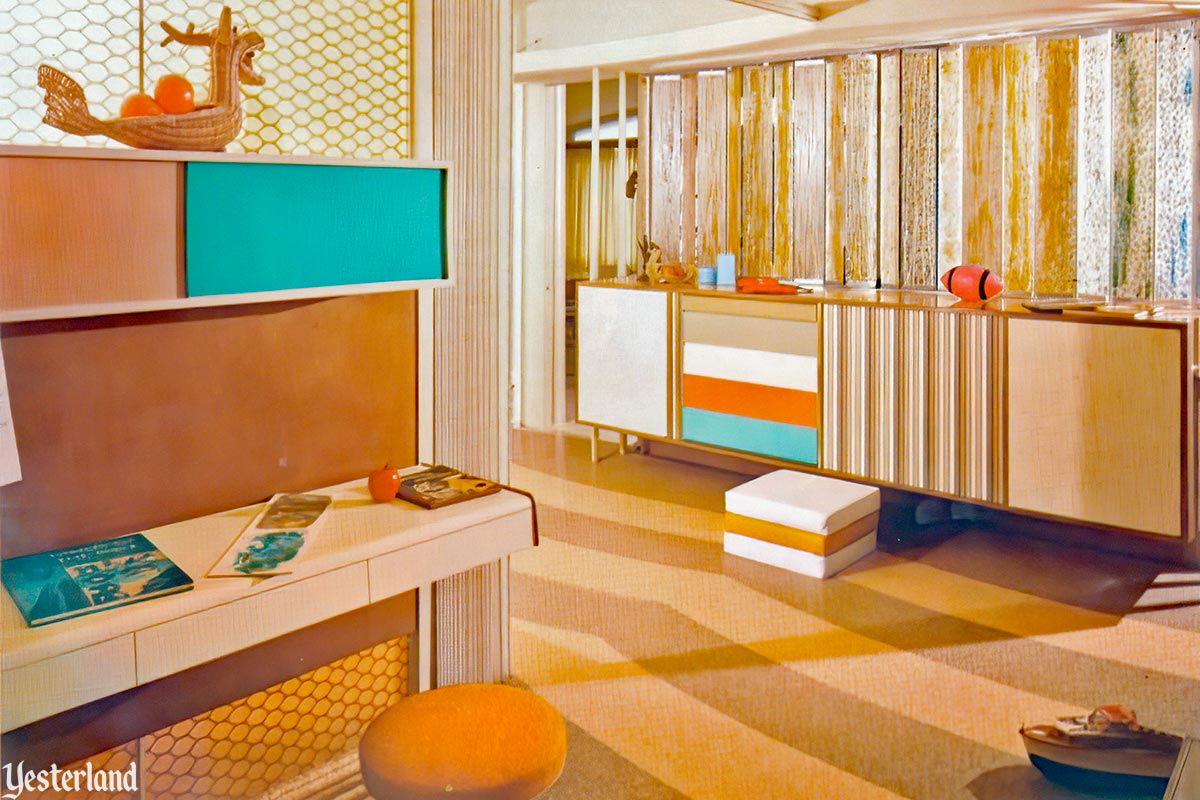
From the collection of Brian Eychner | © Monsanto Chemical Company Children’s rooms with movable folding plastic screens |
||||
|
Pass the two children’s bedrooms—one for the boy of the future and one for the girl of the future—and the shared kids’ bathroom. A movable folding plastic screen allows the rooms to be separated for privacy or combined for a larger play area. Next, see the master bedroom and the main bathroom. |
||||
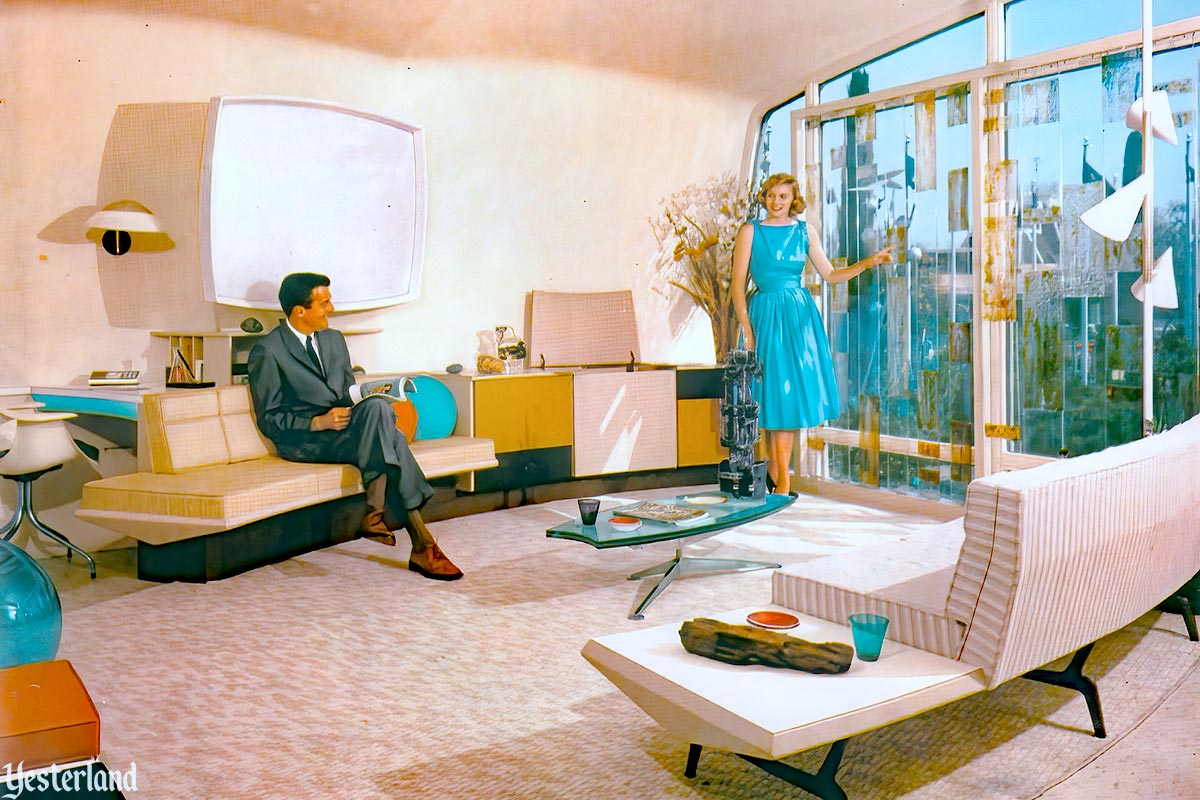
From the collection of Brian Eychner | © Monsanto Chemical Company Living room with a flat-panel TV shaped like a traditional TV screen |
||||
|
The fourth wing is the sleek living room. There’s a huge television mounted on the wall. It’s turned off—and you know why. This technology does not exist. It probably never will. After all, the depth of a television picture tube is related to its screen size. After another glimpse of the wing with the kitchen and family room, you go down another set of stairs to the garden level. Your visit isn’t over yet. |
||||
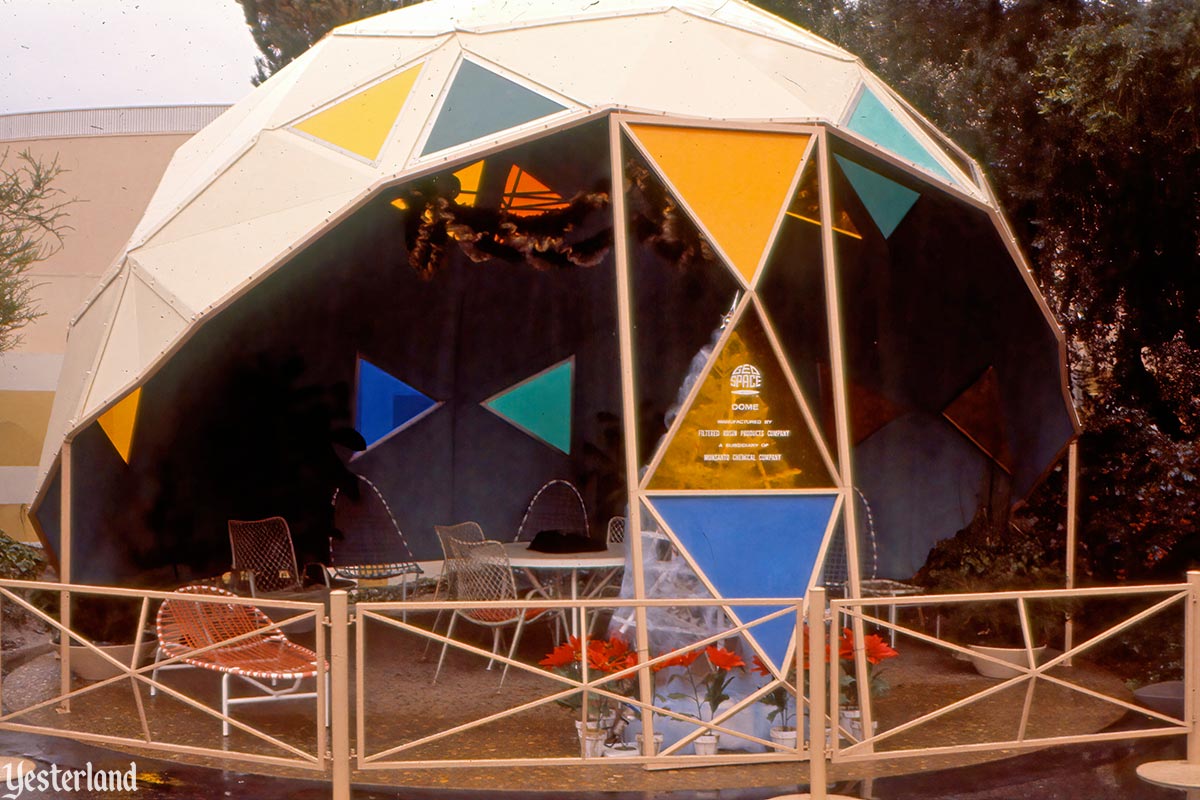
Photo by Roger J. Runck, 1961, courtesy of Robin Runck Geospace Dome for outdoor living |
||||
|
The Geospace Dome is manufactured by Filtered Rosin Products, a subsidiary of Monsanto Chemical Company. It’s an inviting place to relax. Alas, you’re not allowed to sit down, just as you weren’t allowed to sit on the furniture inside the house. |
||||
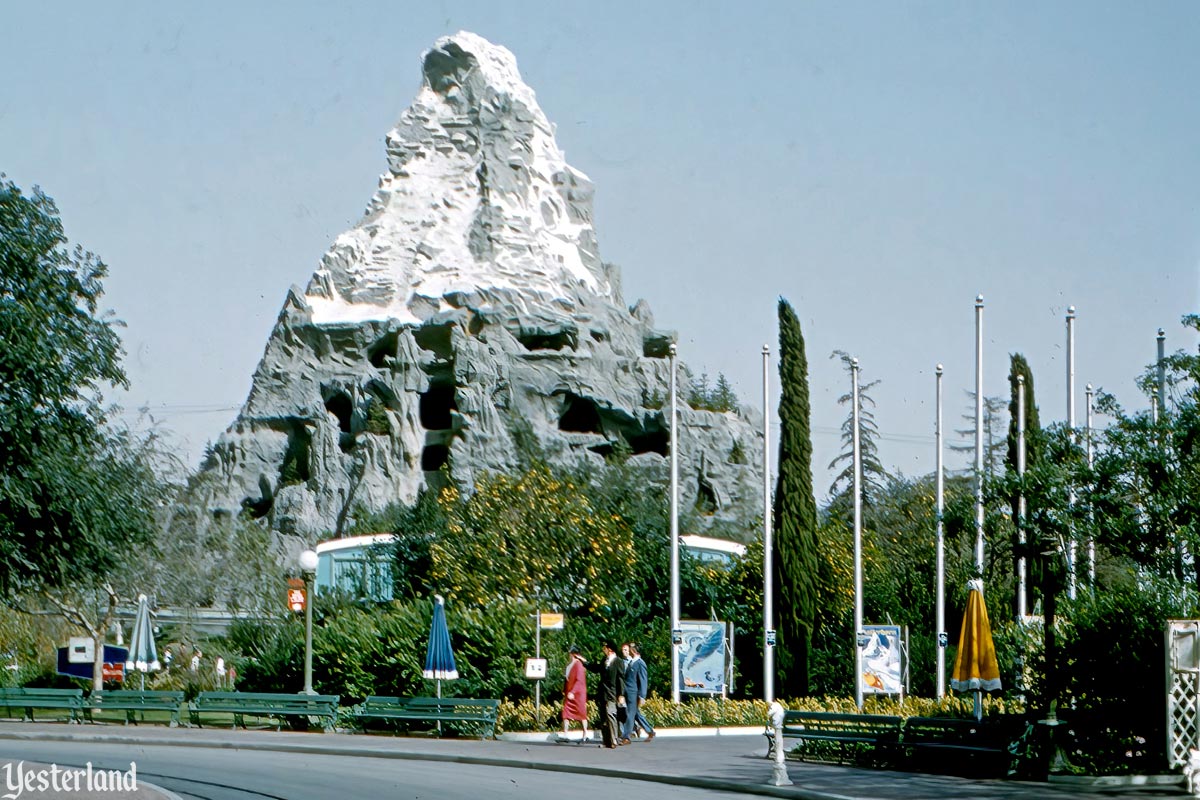
Photo by Roger J. Runck, 1959, courtesy of Robin Runck At the base of brand new Matterhorn Mountain |
||||
|
Are you ready to sell your old home and move into a space age marvel like the House of the Future? How about if it’s also located in the center of the world’s best theme park? |
||||
|
|
||||
|
At Disneyland, the House of the Future opened June 12, 1957 on a prime site just off the Hub, adjacent to the Circarama theater. The House of the Future was one of two free attractions sponsored by Monsanto in the 1950s. The other was the Hall of Chemistry, which closed in 1966. |
||||
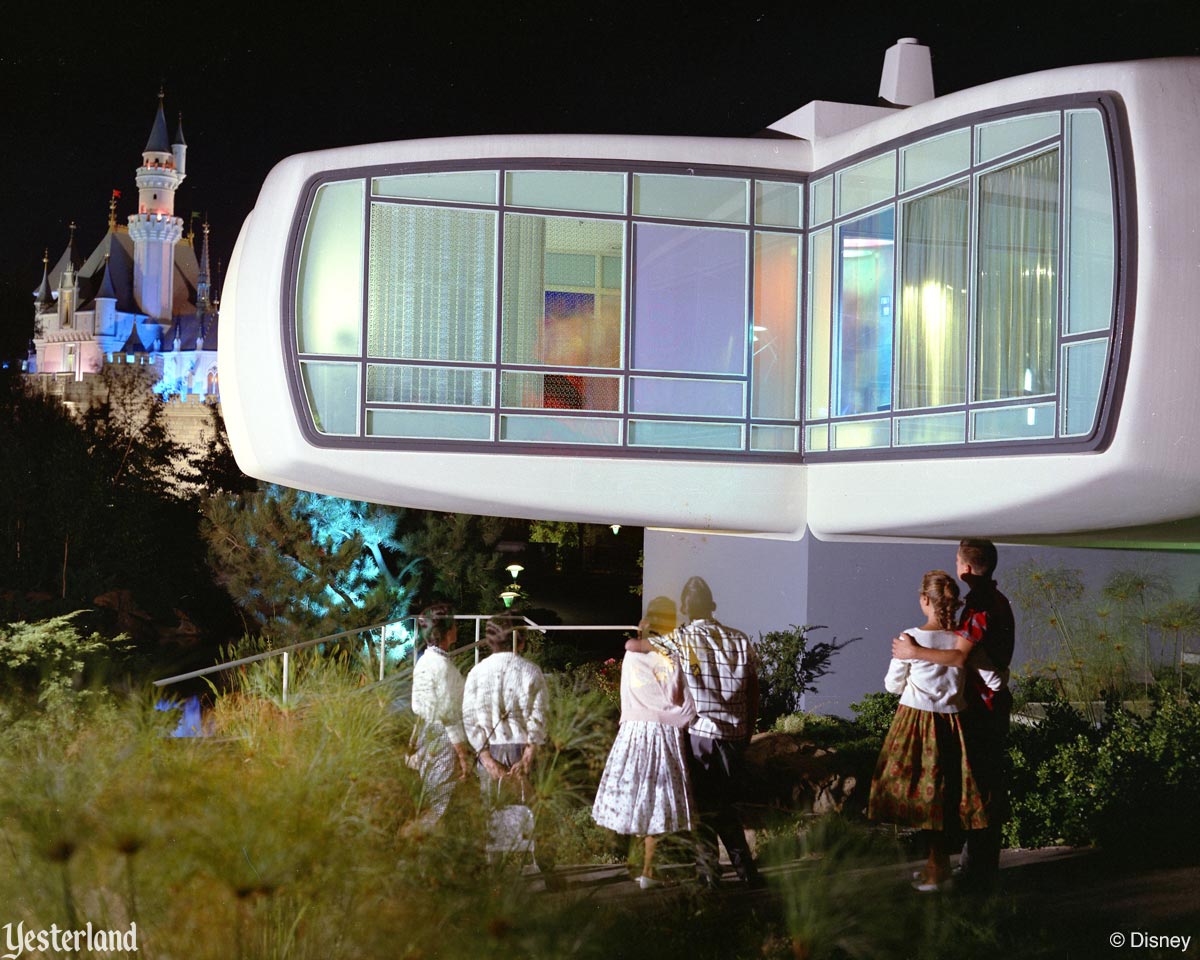
© Disney Particularly inviting publicity photo |
||||
|
The House of the Future wasn’t dreamed up by Walt Disney’s Imagineers at WED Enterprises. That credit goes to the Massachusetts Institute of Technology (MIT). An article in MIT Technology Review (“The House of the Future that Wasn’t,” by Lisa Scanlon, January 1, 2005) summarized how and why the project came to be: “The house was the marriage of converging needs. During the early 1950s, homebuilders could barely keep up with demand as families moved to the suburbs. At the same time, Monsanto Chemical was looking for new markets for its plastic products. Seeing a business opportunity, the company sponsored research at MIT to design a low-cost, prefabricated house that would be made almost entirely of plastic. The researchers suggested the rounded, Jetsons-worthy home—which delighted Monsanto. “MIT architecture faculty members Marvin Goody […] and Richard Hamilton spent two years designing the 1,280-square-foot house. In 1956, Monsanto decided to build a full-scale prototype and Goody and Hamilton formed a private practice to take over the commercial planning of the house. Meanwhile, Walt Disney was searching for exhibits for Disneyland, which had opened in 1955. He heard about the futuristic house and offered Monsanto space to display the prototype.” In 1960, just three years after the House of the Future opened, Monsanto replaced the original decor and furnishings with a new “golden glow” interior. Tastes and technology had changed that quickly. By 1967, the House of the Future seemed dated. Monsanto’s Adventure Thru Inner Space opened August 5, 1967 as part of New Tomorrowland. The House of the Future was doomed. For a brief time, the new ride and the plastic house walk-through co-existed, but in December 1967, the House of the Future closed permanently. Legend has it that the planned one-day demolition of the House of the Future ended up taking two weeks. The wrecking ball had just bounced off the exterior, so workers had to painstakingly cut the house into pieces with hacksaws. After the House of the Future was removed, the house’s landscaping, waterfalls, and walkways remained. The area, named Alpine Gardens, became home to a souvenir stand. In 1996, Disneyland turned the area into Triton’s Garden, with a sculpture of King Triton and delightful jumping fountains. In 2008, Pixie Hollow moved in. The concrete base of the House of the Future is still there. On February 13, 2008, the Disneyland Resort announced that a house of the future would return to Disneyland. The Innoventions Dream Home opened June 17, 2008. It wasn’t a return of the 1957 plastic marvel with visionary predictions. Tucked in the lower level of Innoventions, the future now looked much like the past, only with a lot of new technology. The original House of the Future hasn’t been forgotten. In fact, for an attraction that’s been gone since 1967 because it was outdated, it’s amazing that there have continued to be homage to the House of the Future at Disneyland and Walt Disney World. Monsanto hasn’t been forgotten either, even though the company is gone. In the 1940s and 1950s, Monsanto was primarily a chemicals, plastics, and synthetic fabrics company. In the 1960s, Monsanto became controversial due to its production of Agent Orange for the Vietnam War. In the 1990s, Monsanto began reinventing itself as an agribusiness company. After various acquisitions and spinoffs, the Monsanto of the 2000s and 2010s bore no resemblance to the Monsanto of House of the Future fame. Monsanto became successful—and one of the most hated companies in America—with its pesticides, plant biotechnology, GMO seeds, and business practices. In 2018, Monsanto was acquired by Bayer AG and is no longer a separate entity. It’s sad that the House of the Future was not allowed to remain in Disneyland with continuous upgrades. Although it looked dated in the 1960s, it would have looked incredibly cool again a decade later—and still today. With the introduction of Fujitsu’s plasma televisions in 1997, the living room could even have had a working flat-screen TV on the wall. |
||||
|
A Video, More Photos, and a New Book |
||||
|
There are a lot more great photos of the House of the Future just a click away. A second click will show you a 2½-minute video that’s well worth watching. |
||||
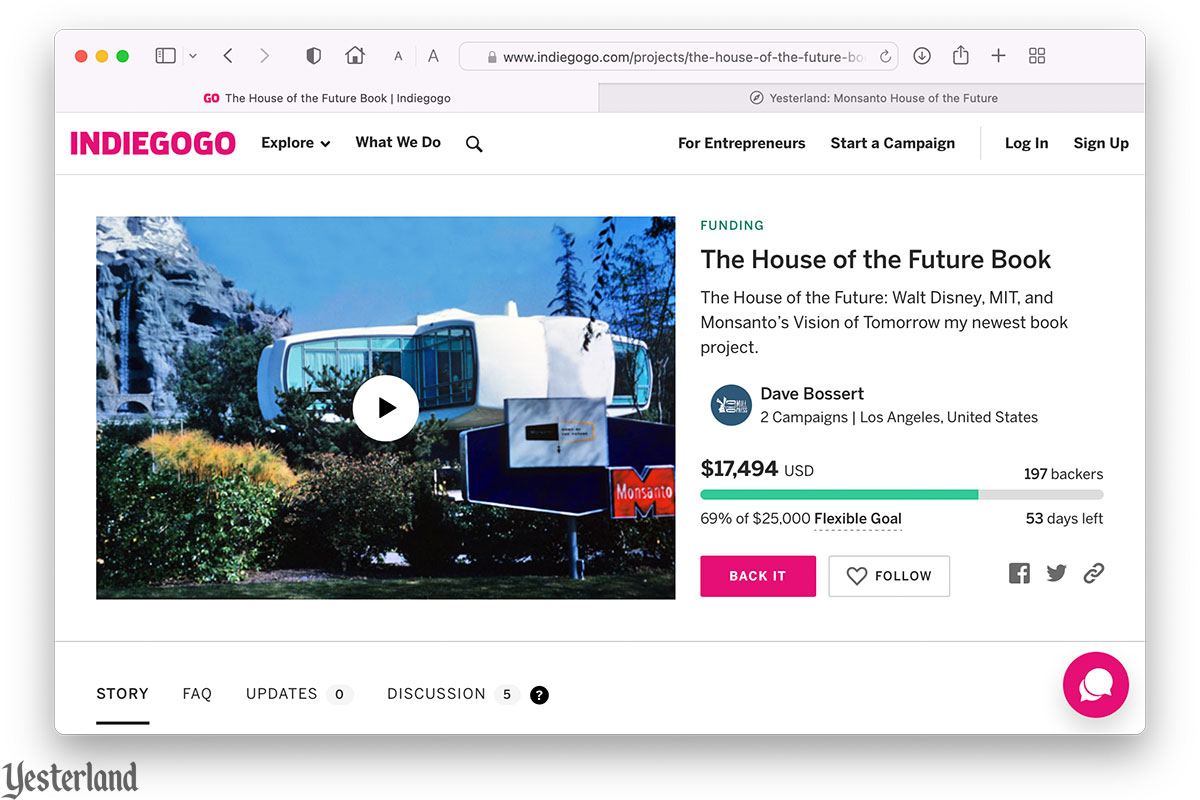
Screen capture, February 9, 2022 | © 2022 Indiegogo, Inc. Dave Bossert’s Indiegogo campaign |
||||
|
Dave Bossert—artist, filmmaker, Disney historian, and author—is working on a new book, The House of the Future: Walt Disney, MIT, and Monsanto’s Vision of Tomorrow. Click on the screen capture or book title above to bring up a new window with the Indiegogo page—the video, photos, and information about the book. Are you familiar with these other two books by Dave Bossert?
Yesterland is a participant in the Amazon Services LLC Associates Program, an affiliate advertising program designed to provide a means for sites to earn advertising fees from qualifying purchases by advertising and linking to Amazon. |
||||
|
|
Click here to post comments at MiceChat about this article.
© 2022 Werner Weiss — Disclaimers, Copyright, and Trademarks Updated February 11, 2022 |
|||